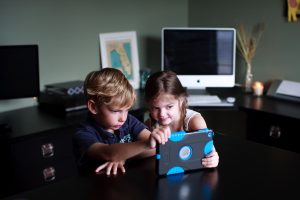*UPDATED with new apps- May 2024
Reading Time: 3 minutes
Written By: Amy Fuchs
Maybe you have asked yourself any or all of the following questions when someone has mentioned social stories:
What are they?
How can they help in the classroom?
Aren’t social stories only for children with Autism?

Let’s talk truth about social stories. Carol Gray is credited with developing Social Stories when she was teaching students with Autism 30 years ago! The idea is used by many professions that work with individuals of varying abilities, not just Autism.
The term “social story” sometimes implies something complicated. “Stories” are hard to write, right?!? Not so. A social story should be brief, use simple vocabulary, and pictures are often helpful. Anyone can write a social story, you don’t have to be a trained professional!
Use social stories to prepare students for new activities or events throughout the school day. If you have never used social stories, you may not realize how helpful they can be in big and small situations and how very easy they are to create. Consider these scenarios:
- When introducing a new center or activity to your classroom, use a social story with 4 or 5 steps that gives students the expectations for that center. After you demonstrate the expectations to the class, students who need it could have a reminder card of the steps.
- How about going on a field trip to a play or a museum? Students need to know expected behavior. Use a short, simple social story to remind them of the basics, “we don’t talk while the actors are on stage”, etc.
Let’s take the example of going on a field trip to a museum. What are the most important things you want your students to know (think safety issues, behaviors that are and are not allowed, etc.)? Make yourself a list of these things, then put them in an order close to how they might occur or when they are necessary for the students to know (i.e. touching items in the museum without an adult giving permission- the temptation to touch will be there the moment you enter the front doors).
You can also use social stories with students who easily become frustrated and need reminders of how to calm themselves and work through their frustration.
Social stories are teaching tools that take a little work to create and set up initially, but will “pay off” in their daily use by making your classroom run much more smoothly.
Here are a few apps related to social stories that you may find helpful as you get started creating them on your own.
Social Story Creator Educators is an app that helps you to build your own personalized social story. This approach typically works best for younger children as well as people of any age with intellectual or learning disabilities as it is personalized to them with accurate names, pictures, etc.
Florence was developed with older teens and young adults in mind and tackles subjects related to relationships, heartache, and growth using images and music to tell a story from a fictitional young woman’s perspective. This could be a great addition to a social skills group for teens and young adults.
The Social Express II uses video modeling to help children, teens, and young adults to solve social problems. The videos are fully animated, interactive lessons that target skills such as identifying feelings in others, reading non-verbal social cues, learning how to start conversations, and more.
TextingStory Chat Story Maker is a new twist on teaching social skills that uses the same format as text messaging. This is brilliant since teens and young adults use this regularly to communicate. The app allows you to create stories by switching back and forth from one communicator to the other, so the story shows up in a text strand format.
Click on the image below for a printable summary of this information:

If you are interested in searching for more apps, creating your own list of apps and sharing them, please go to BridgingApps.org. BridgingApps, a program of Easter Seals Greater Houston, is a community of parents, therapists, doctors and teachers who share information about using mobile devices with people who have special needs.
